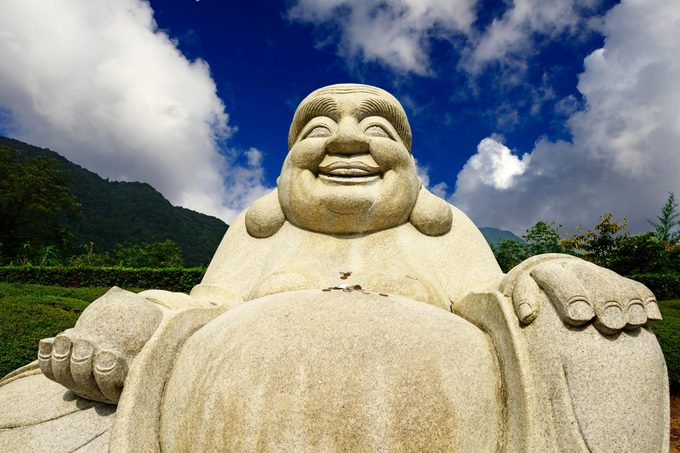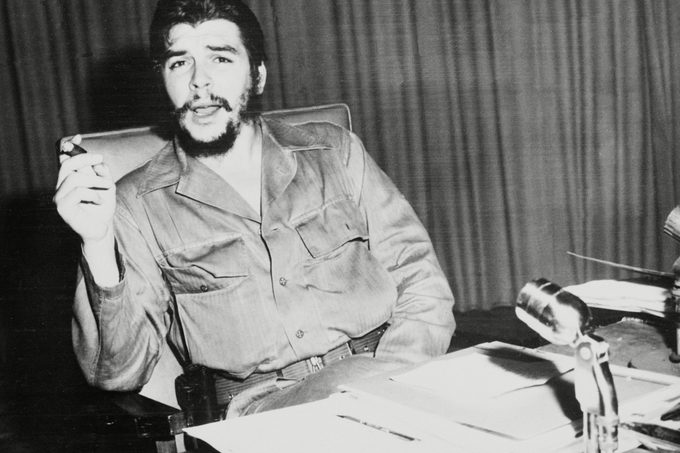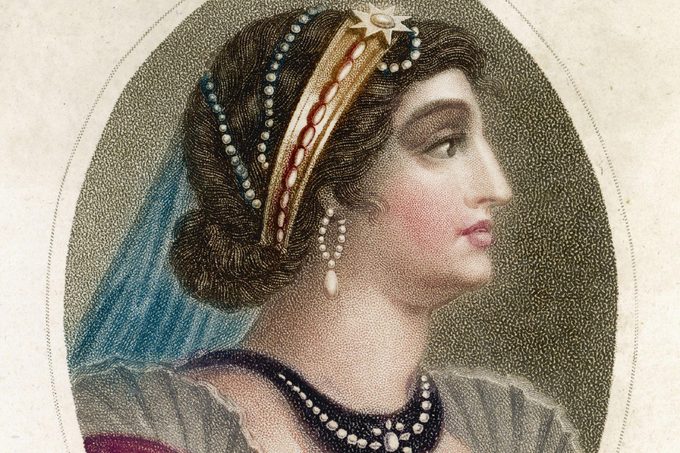 Everett Historical/Shutterstock
Everett Historical/Shutterstock
If you peruse portraits and photographs of notable men from the 18th and 19th centuries, you might notice that many of them sport the same fairly unnatural-looking pose. They sit or stand while keeping one hand tucked into the front of their jackets. They look like they’re trying to appear stately for the picture while also trying to keep the painter from pick-pocketing their wallet. With depictions of everyone from Napoleon to Joseph Stalin using the gesture, historians and curious art aficionados have puzzled over its meaning. Get a look at some rarely seen historical photos you won’t find in textbooks.
No, it’s not a secret Masonic code or a reference to an Illuminati ritual. The tradition actually dates back long before the 1700s. According to Today I Found Out, some societal circles in ancient Greece considered it disrespectful to speak with your hands outside of your clothing. Statuary from the sixth century BC, therefore, showed celebrated orators such as Solon with their hands tucked into their cloaks.
Little did the ancient Greeks know that their legacy would carry on a whopping 24 centuries later. In the 18th century, artists began looking to antiquity for inspiration. What did they find but statues of celebrated speakers, posed with their hands in their cloaks. Portraitists began representing subjects in a similar pose, believing that it conveyed a noble, calm comportment and good breeding.
One of the most recognizable historical figures to be depicted in this pose was Napoleon Bonaparte himself. Several portraits of the French emperor show him with one hand in his jacket, leading theorists to wonder if he was clutching a painful stomach ulcer. One painter, Thomas Hudson, painted so many men in this pose that his contemporaries wondered if he simply wasn’t good at painting hands.
With the advent of photography in the early 19th century, the trend continued. Major historical figures—everyone from U.S. president Franklin Pierce to Communist Manifesto author Karl Marx—were photographed with unbuttoned jackets and hidden hands. It wasn’t until the end of the 1800s that the pose’s prevalence began to decline. But, even after that, it popped up in photographs every now and then; Joseph Stalin adopted the stance in a 1948 photo. Next, see if you can identify these historical figures from only one image.
10 Historical Figures You’ve Been Picturing All Wrong
 Norbert Eisele-Hein/imageBROKER/REX/Shutterstock
Norbert Eisele-Hein/imageBROKER/REX/Shutterstock Buddha
You've likely seen fat, smiling "Buddha" statues in Chinese restaurants, antique stores, or gardens, but did you know that little guy is not actually the "real" Buddha? It's actually Budai, the "laughing Buddha," who is a reincarnation of the "real" Buddha, Siddhartha Gautama. The "real" Buddha was actually thin, because in the Buddhist tradition, once you've become "enlightened," you no longer crave the pleasures of the world. Gautama spent half of his life in wealth and half in poverty, in order to find the ideal balance. His philosophy became the modern Buddhist religion.
 Universal History Archive/UIG/REX/Shutterstock
Universal History Archive/UIG/REX/Shutterstock Pocahontas
Thanks to Disney, Pocahontas is perhaps the world's most misunderstood historical figure. She was born in 1596 under the name Ammonite (she also had the more private name
Matoaka), and the name Pocahontas was actually her nickname. When the Europeans came to colonize the Powhatan land, Pocahontas did not turn her back on her family to join the European crusade. She occasionally brought food to the settlers to ease tensions between the two peoples, and was later imprisoned by the Europeans and
converted to Christianity. Contrary to popular belief, Pocahontas did not marry John Smith––she actually married a tobacco farmer named John Rolfe. She died in 1617 from an illness, but was instrumental in attempting to make peace between the Powhatan people and the Europeans. Learn more
fascinating facts about America that your history teacher didn't tell you.
 Shutterstock
ShutterstockChe Guevara
The charismatic Marxist revolutionary, who helped overthrow the Cuban government with the Castro brothers, is often seen as just that. He is seen by some as inspirational and by others insufferable. However, while most people are aware of his rebellion and passion for the counterculture, they don't know that he was also a
ruthless executioner. He oversaw the executions of hundreds of men in Cuba during the early days of Fidel Castro's government. Feeling like everything you thought you knew has been debunked? Find out the
16 history questions everyone gets wrong.
 Universal History Archive/Universal Images Group/REX/Shutterstock
Universal History Archive/Universal Images Group/REX/ShutterstockOliver Cromwell
Cromwell was Lord Protector of the Commonwealth of England, Scotland, and Ireland in the mid-1600s. In 1653 he declared the Parliament corrupt and got rid of them by force; many saw him as a hero for this. Afterward, he became the Lord Protector. But what many don't know is that Cromwell actually was
involved in Irish massacres in a move to help the English gain control of the country. So, while many have seen him as a hero for destroying the corrupt Parliament, he was actually pretty corrupt himself.
 Historia/Shutterstock
Historia/ShutterstockCleopatra
Cleopatra is widely known for her beauty and sex appeal. However, she was the last Pharaoh of ancient Egypt. She began ruling with her father, but later was the sole ruler... of an entire empire! That's not a simple feat. Most people reduce her to her looks, especially because of her relations with Caesar and Mark Antony, despite her powerful reign. Check out the
12 historical predictions that totally, completely missed the mark.
 Universal History Archive/Universal Images Group/REX/Shutterstock
Universal History Archive/Universal Images Group/REX/ShutterstockAlexander Graham Bell
Alexander Graham Bell. who is recognized as the inventor of the telephone, is actually a phone-y (pun intended!). The actual inventor was an Italian living in New York named
Antonio Meucci. He invented a functioning telephone five years before Bell, and filled out a "patent caveat," which is a precursor to a real patent. As the story goes, Meucci couldn't afford to file the official patent, and Bell stole it right under his nose.
 Historia/REX/Shutterstock
Historia/REX/ShutterstockPontius Pilate
Pilate is typically known as the ruler who joyfully ordered the crucifixion of Jesus Christ, but that may be a myth. While Pilate was certainly a harsh ruler, some historians
suggest that Pilate was reluctant to crucify Jesus and believed he was innocent. Check out the
messed-up history facts you definitely didn't learn in school.
 Universal History Archive/Universal Images Group/REX/Shutterstock
Universal History Archive/Universal Images Group/REX/ShutterstockVincent Van Gogh
The "Starry Night" painter we know and love actually fits the "tortured artist" persona, despite many of his bright paintings. Van Gogh suffered from depression and lived in poverty—he was an unknown and unloved artist in his time. Even though he had over 2,000 paintings which now sell for millions of dollars, he only sold one in his lifetime.
 Historia/REX/Shutterstock
Historia/REX/ShutterstockConfucius
Confucius is typically regarded as a religious figure. The founder of the Chinese philosophy of Confucianism,
Confucius actually had nothing to do with religion. The traditions of
Confucianism were based on typical Chinese beliefs and morals: family, respect for elders, and the rights of others. While many people associate these morals with religions, Confucianism is known as a philosophy––no deity involved. Confucius was just the teacher and politician that became recognized by the Chinese government for his principles. Find out the
10 famous people that may have never actually existed.
 imageBROKER/REX/Shutterstock
imageBROKER/REX/ShutterstockChristopher Columbus
In recent years, different activist groups have shed light on the fact that
Christopher Columbus should not necessarily be celebrated for "discovering" America. Columbus was an accomplished explorer, traversing the seas multiple times in the 1400s. He was actually looking for South Asia when he stumbled upon the large land mass we now know as North America in 1496. He is falsely credited for discovering America; it's believed that European explorers had explored Canada several hundred years earlier, and Columbus actually never stepped foot in what is now North America. It is also widely known that Columbus took part in the enslavement and mistreatment of the peaceful Native American tribes he came in contact with in the Caribbean and contributed greatly to destroying native populations. Next, find out the
11 biggest lies that made history.





























